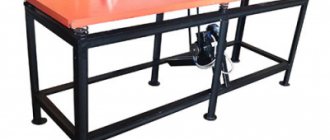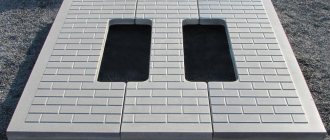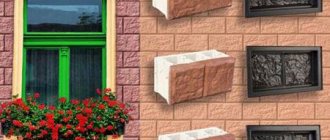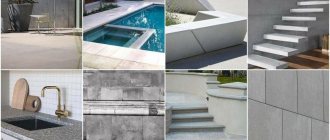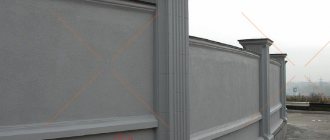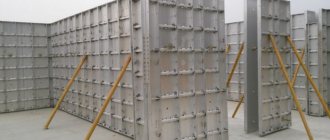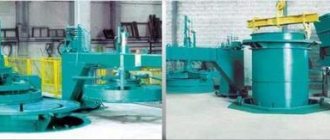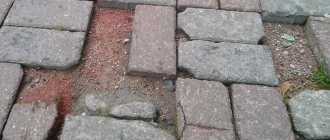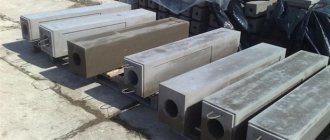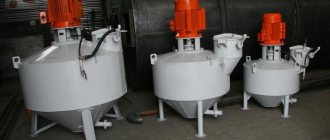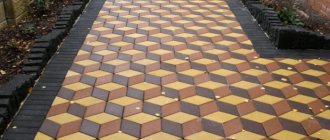Molds and products made using them
Among the structural elements of buildings and landscape design elements, concrete products are the most common. These are wall blocks, columns, tiles, small architectural forms, and much more. They are made by pouring concrete into molds. And they do this not only in industrial settings.
Plastic molds for concrete products allow you to set up your own mini-production or cast piece products for personal use.
Today on sale you can find different versions of such forms, differing both in shape and size, and in the material from which they are made. Plastic products are perhaps the most popular. Let's talk about their features and selection criteria.
Making concrete products using molds
Paving slabs and similar concrete products are made in two ways: vibrocompression and vibrocasting.
- Vibrocompression is used in fairly large flow productions using special equipment - a vibropress. The solution is poured into matrices and subjected to vibration compaction. The pressing punch extrudes a certain pattern onto the front surface of the product. Molds for this production method must be strong and rigid. As a rule, they are made of metal. The disadvantage of the method is the small variety of types of products produced.
In the photo - a mold for the production of paving stones
- The vibratory casting method involves placing plastic concrete molds filled with a solution on a vibrating table - a vibrating surface on which the raw materials are compacted and tamped. The type of finished products depends on the range of forms, and it is much more diverse than in the previous case. Such forms are made from different types of plastic, silicone, rubber.
Plastic mold for 3D wall panels
The latter method does not require the use of complex equipment; it is often used to make decorative concrete elements with your own hands.
Lifehack: DIY silicone molds
The role of silicone in our life
Silicone has become the main material of the 21st century. He is present in our lives much more than we think. Silicone is used in industry. manufacturing, space and automotive industry, repair and construction (sealing), medicine (contact lenses), cosmetology (care products, injections), cooking (potholders, molds) and electronics.
A group of synthetic silicone polymers has many beneficial qualities for humans. The main one is inertia. Silicone itself does not have any effect, it only forms a thin breathable film.
How to choose the right forms
If you are going to set up your own mini-production or produce a large number of concrete products for personal purposes, you will have to choose the necessary forms from the large assortment offered for sale today. What should you pay attention to?
Type of products
Using molds you can make many products for various purposes. For example, paving slabs, paving stones, curbs and curbs, gutters, facade panels and tiles, fences, monuments, garden sculptures, etc.
Molds for concrete hemispheres
From the variety offered, you need to select matrices that are suitable in size and geometric configuration.
Installation method
Such products differ in the method of use: they can be solid or collapsible.
- Solid forms are made from elastic and semi-rigid materials; they are easily removed from shaped products without violating their integrity.
- Collapsible molds are used for the production of products of a strict configuration and are made of hard plastic.
Using collapsible molds, three-dimensional products are obtained: vases, balusters, etc.
Material of manufacture
Matrices for concrete casting, depending on the material of manufacture, have different properties and characteristics:
- Fiberglass forms for concrete, thanks to the use of reinforcing glass fiber, have high strength, especially at low temperatures. At the same time, they are rigid and not elastic.
Collapsible forms for concrete made of fiberglass
- ABS plastic is an impact-resistant synthetic polymer, characterized by high heat resistance and a wide range of operating temperatures: from minus 40 to plus 90 degrees. Resistant to moisture, detergents, acids and alkalis.
ABS plastic product
Note. This material is resistant to exposure to ultraviolet radiation and direct sunlight.
- PVC plastic is a chemically resistant thermoplastic polymer. Compared to ABS plastic, it is less heat-resistant and frost-resistant, and less durable. But its price is much lower.
PVC plastic mold
Production of paving slabs
- Silicone and polyurethane are high-quality materials for the production of flexible matrices intended for the manufacture of decorative elements with a clearly defined texture. Removing products from elastic molds is easy and quick.
Polyurethane matrix
For reference. The holding time of the solution in flexible polyurethane forms is less than in plastic ones.
When are they needed?
Molds for concrete products are indispensable in the manufacture of construction and decorative products by casting. The smaller and more refined the parts, the higher the quality requirements for the matrices. With their help, various construction samples and products for concrete decorations are produced:
Adaptations are necessary for those who make paving slabs.
- blocks for construction;
- fencing;
- paving slabs;
- reinforced concrete slabs;
- architectural accessories;
- blocks or rings for fireplaces;
- drainage trays;
- monolithic or hollow products.
What else to pay attention to
Of course, the most basic selection criteria are the quality and cost of the products. High quality can only be achieved by manufacturing molds and good raw materials using modern technologies.
What are the requirements for these products? They can be divided into technical, decorative-aesthetic and economic.
Technical requirements
These include:
- Light weight . Unlike metal or wood, all plastic forms have this advantage.
- Low adhesion to concrete. In order not to rack your brains about how to clean plastic molds from concrete or what to lubricate them with before pouring the solution, you need to choose products that do not “stick” to it.
Cleaning molds from solution
Advice. Manufacturers usually recommend products for lubricating and cleaning plastic molds. But the drugs are not cheap and increase the cost of finished products. Therefore, instead of a special lubricant, you can use sunflower oil or a soap solution, and clean it with ordinary water immediately after stripping. If time is lost and the solution has dried out, before cleaning plastic forms from concrete with proprietary products, try using a 5% solution of hydrochloric acid or a 35% solution of acetic acid.
Lubricant is applied with a brush or spray
- Ease of unmolding . Products must be removed from the mold without vibration or steaming.
Finished products should be easy to remove from the mold
Decorative and aesthetic requirements
The shapes must have clear edges so that the quality of the geometric parameters of the finished products is at their best.
It is worth paying attention to the quality of texture transfer. In this regard, soft and elastic forms are preferable to rigid or semi-rigid ones, but are inferior to them in maintaining geometric parameters.
Removing the flexible mold
It is also better to give preference to products with low abrasive wear, due to which finished products will lose their attractive appearance over time.
Economic requirements
The cost of plastic molds is a relative concept. When purchasing them, you need to take into account another parameter - the cost of one removal. What does this mean?
The operating instructions for any injection mold take into account their service life or the number of removals - cycles of pouring and unmolding while maintaining the operational characteristics of the product.
The number of products made with its help depends on the service life of the mold.
For example, the service life of PVC molds does not exceed 50 cycles. At a cost of 900 rubles, the price of one rental will be 18 rubles.
At the same time, the service life of ABS plastic molds is about 300 cycles. Despite the fact that they can cost twice as much, each meal will cost much less - from 5-6 rubles.
Note. This parameter is important only in the case of constant and regular use of matrices. For example, when organizing the production of concrete products for sale. If you need to make a limited number of elements for personal needs, without using the entire resource of plastic molds, look at their cost.
How to surprise your neighbors: expert advice
Proportions of concrete mortar components.
If a person is not yet a master of casting complex figures from concrete, then the following idea will be useful to him. This is a mushroom figure that you can place on your summer cottage - your neighbors will be surprised.
The mushroom stem requires a filling mold. You can take a piece of linoleum or a plastic bottle. The shape should be tubular and a piece of reinforcement should be placed in the middle. Concrete is poured and left to dry.
The mushroom cap is made in the simplest way. A hole is dug in the sand, a burdock leaf is spread to the bottom (the mushroom cap will look like a real one). The hole is filled with ready-made concrete. After thirty minutes, you can insert several large nails into the head (in the center of the head). The product dries.
After the filling has dried, the product is removed from the mold and fixed to the ground. The upper part of the mushroom leg is filled with concrete and the mushroom cap is lowered onto it. Just wait a week, the mushroom will be ready for decoration and coloring.
There are always a lot of flowers in the garden plot. All materials that are at hand are suitable for flower beds. Especially if the forms have a complex design, then the flowerpots will not only please the eye, but also surprise with their masterpiece.
For production, high-grade cement should be used; it will give strength to the flowerbed. The solution prepared for pouring must be made thick. The mold used is coated with oil (can be used machine oil). This will allow you to easily remove the finished product. If the walls are not thick enough, they can be reinforced. After pouring, the product dries within several days. But it should dry in the shade, and not in direct sunlight. After removing the flowerpot, it is necessary to wrap it in wet burlap and cellophane for another week, this will help to avoid cracks in the product. Next, you should drill holes to drain excess moisture. Such a flowerpot can be painted with any type of paint, shells, mirror chips, and small stones can be glued onto it. The decor is to the taste of the owner. These types of flower beds will become a real decoration at any time of the year.
Summarizing all of the above, it should be noted that the process of pouring concrete into molds can be an excellent idea for creating your own business. Such a business has its advantages: it does not require large start-up capital, a simple workflow, and a short payback period for investments. Such a business can become not only an additional source of cash income, but also the main one.
You can make a vibrating table yourself, just like concrete forms. You will have to spend money on a concrete mixer, but at first you can rent one. If you both want and are scared to start something new for yourself, then you can try your hand at making a small product for personal use on your site, for example, making the same paving slabs for a path. It is in demand in the building materials market. After all, asphalt emits toxic fumes into the air during hot summers, and concrete pavement cracks at high winter temperatures. And covering with paving slabs allows you to replace worn parts in small areas or individually. So it’s worth taking a risk, and suddenly it will be the work of your whole life.
Areas of use
Matrices for large building structures.
Since concrete began to be used as a building material, the possibilities for using products made from it have expanded.
This is what comes out of the mold and what we see every day.
- Statues, flowerpots, borders in parks and squares.
- Construction concrete blocks.
- Concrete paving slabs of various shapes.
- Facsimile copies.
- Architectural accessories.
- Trays for drainage.
- Reinforced concrete slabs for construction.
- Fences, including decorative ones.
Die lubrication is often of great importance.
Note! The higher the detail of the product, the better the quality of the mold for casting it. The range of materials for molding equipment and the relative ease of processing allows you to make your own stamp for producing your own products.
